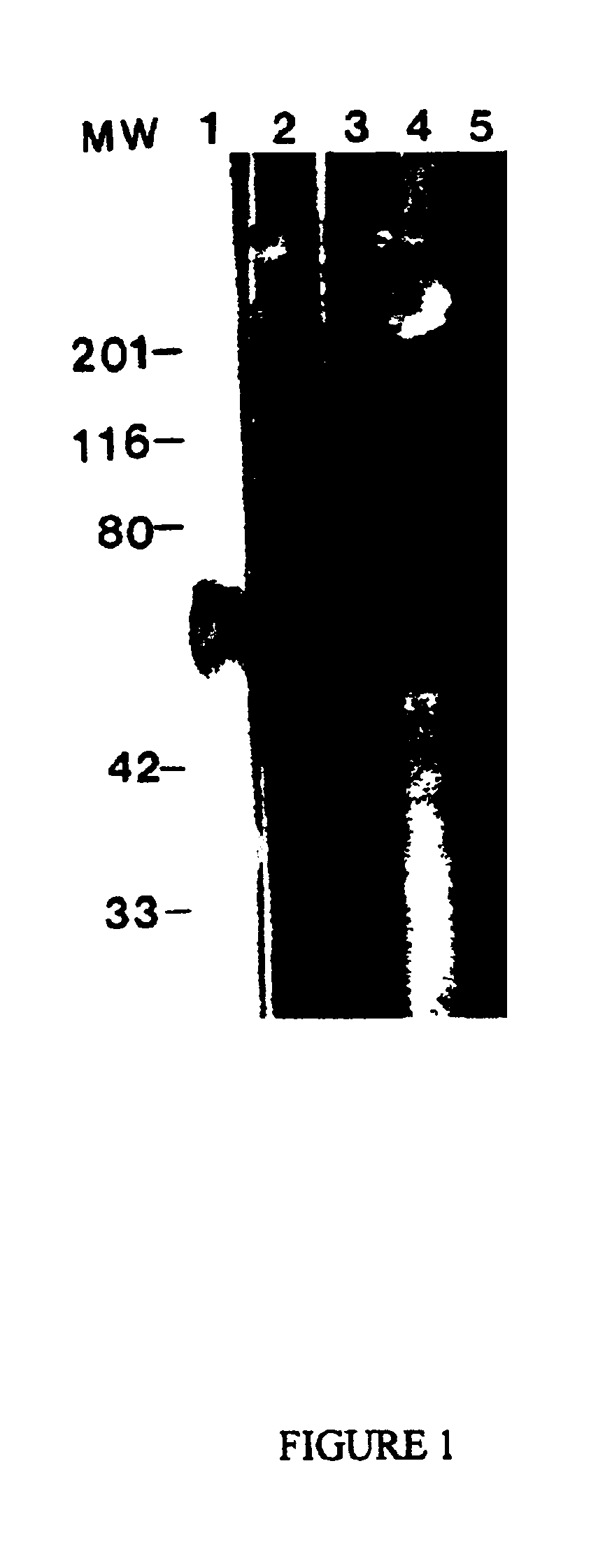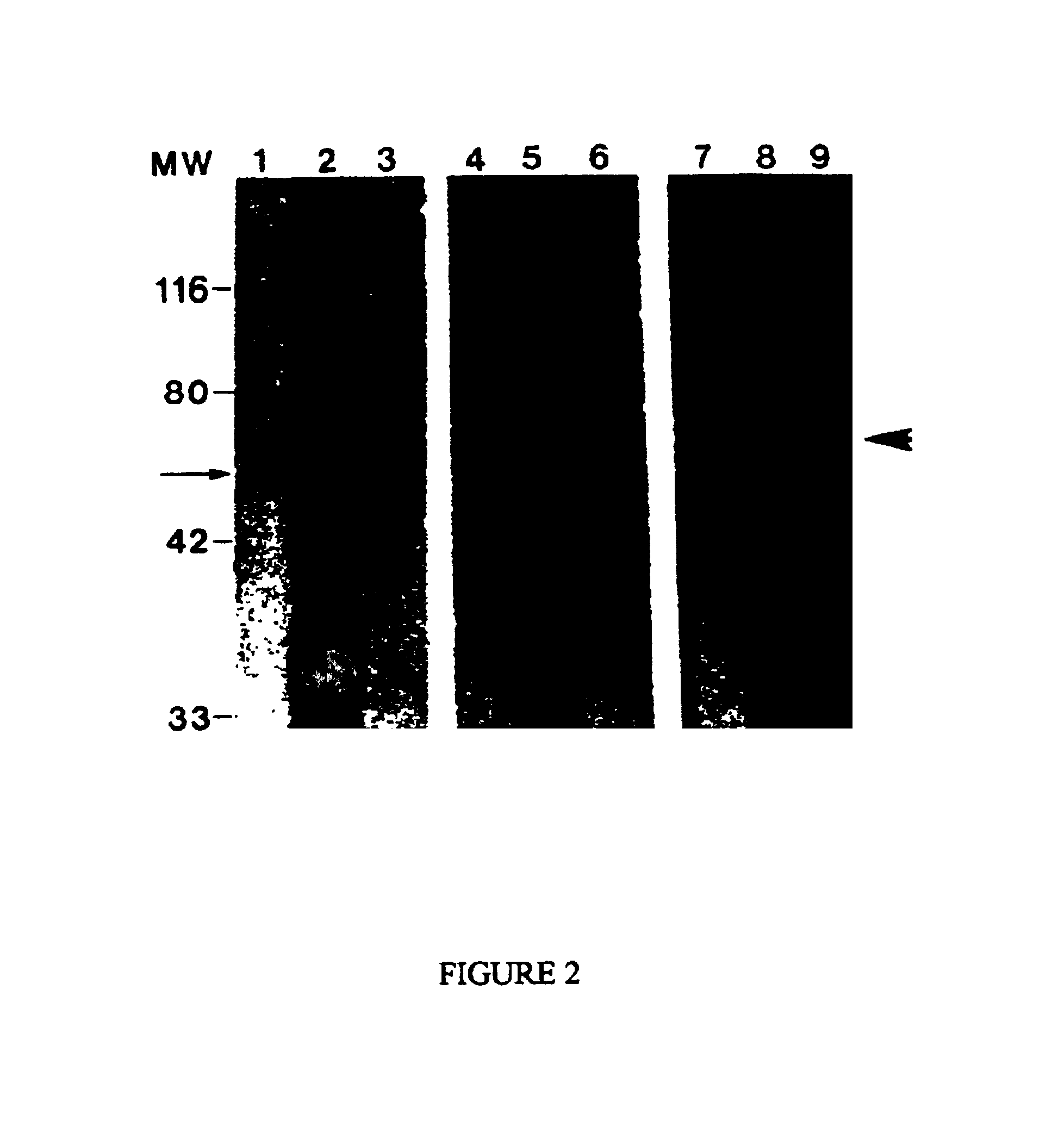Purified antigen for Alzheimer's disease and methods of obtaining and using same
a technology of purified antigen and alzheimer's disease, which is applied in the field of preparation comprising alzheimer's disease antigen, can solve the problems of no positive, difficult diagnosis of alzheimer's disease, intellectual deficit, etc., and achieve the effect of enhancing their reactivity
- Summary
- Abstract
- Description
- Claims
- Application Information
AI Technical Summary
Benefits of technology
Problems solved by technology
Method used
Image
Examples
example 1
Isolation of a Partially Purified A68 Antigen Preparation
This Example describes the isolation of a partially purified A68 antigen preparation.
A68 antigen was isolated from frozen human brain samples (typically the cerebral cortex from an Alzheimer's disease patient), by homogenization in 5 volumes of an aqueous buffer such as tris buffered saline (TBS), containing standard protease and phosphatase inhibitors. The homogenate was fractionated by centrifugation at 27,000×g for 60 minutes at 4° C., and the supernatant was collected and passed over an MC1 affinity column iteratively for 16 hours at 4° C. The MC1 column was prepared by coupling a purified mouse monoclonal antibody which reacts specifically with A69 (MC1, described in PCT International Application WO 96 / 20218, and deposited in terms of its source, secreting hybridoma ATCC No. 11736, with the American Type Culture Collection, Rockville, Md. on Oct. 26, 1994) to Affigel-10 (Biorad Laboratories) according to manufacturer's in...
example 2
Protein A / G Treatment of A68 Preparations
This Example describes the further purification with use of protein A / G of an A68 antigen preparation obtained, for instance, as described in Example 1. Unless otherwise specified, all chemicals for this study, and those in the following Examples, were purchased from Sigma (St Louis, Mo.).
To remove the contaminating Ig's prior to analysis of serum autoantibodies, the A68 preparation was incubated with both Protein A and Protein G immobilized on agarose beads (Immunopure Immobilized Protein A, Immunopure Immobilized Protein G; Pierce, Rockford, Ill.). Briefly, 1 ml of A68 was added to 75 μl of packed Protein A beads and 75 μl of packed Protein G beads. The sample was placed on a rotator for 8 hours at 4° C. After incubation, the beads were spun out of solution in a microcentrifuge at 14,000×g for 3 minutes. The A68 supernatant was then transferred to a new tube containing 75 μl each of packed Protein A and Protein G beads and allowed to incuba...
example 3
Western Blot Analysis
This Example describes Western blot analysis of an A68 antigen preparation that has been purified to be substantially free of immunoglobulin by treatment with Protein A / G, as described in the preceding Example.
Gel electrophoresis was performed using the method of Laemmli (Nature, 227 pp. 680-685 (1970)), employing 10% SDS-polyacrylamide minigels of about 1.5 mm thickness. Protein A / G treated A68 was loaded at about 100-1000 ng total protein / lane in sample buffer.
Western transfer was performed according to the method of Towbin et al. (Proc. Natl. Acad. Sci. USA, 76, pp. 4350-4354, (1979)) using either 0.45 μm or 0.2 μm nitrocellulose (Micron Separations Inc. Westboro, Mass.). Following transfer, the nitrocellulose blots were removed and put into blocking buffer consisting of 5% nonfat dry milk in borate buffered saline (BBS, 75 mM NaCl, 100 mM H3BO3, 25 mM B4Na2O7:10 H2O) for about 2 hours at room temperature. The nitrocellulose was then cut to separate the indiv...
PUM
| Property | Measurement | Unit |
|---|---|---|
| molecular weight | aaaaa | aaaaa |
| pH | aaaaa | aaaaa |
| thickness | aaaaa | aaaaa |
Abstract
Description
Claims
Application Information
 Login to View More
Login to View More - R&D
- Intellectual Property
- Life Sciences
- Materials
- Tech Scout
- Unparalleled Data Quality
- Higher Quality Content
- 60% Fewer Hallucinations
Browse by: Latest US Patents, China's latest patents, Technical Efficacy Thesaurus, Application Domain, Technology Topic, Popular Technical Reports.
© 2025 PatSnap. All rights reserved.Legal|Privacy policy|Modern Slavery Act Transparency Statement|Sitemap|About US| Contact US: help@patsnap.com


